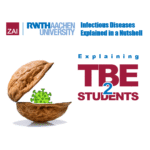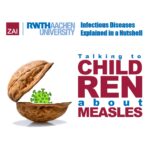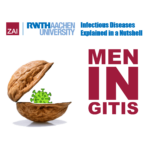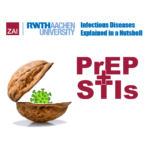Tick Tock, TBE O’Clock: Your Exam-Ready Guide about Tick-Borne Encephalitis
Disclaimer!
This article and its major media content are produced by students to train science communication as part of a lecture about human infectious pathogens. The article does not represent official advice from the authorities. For authorized information about the disease in question, please refer to the official health authorities in your country or the World Health Organization.
By Franziska Fohn, Gina Auerswald & Jana Egner-Walter
Do you know this moment, where you realize you procrastinated a bit too long and now your virology exam is approaching? Don’t worry! In just a few minutes, here you will learn all the important molecular mechanisms and clinically relevant facts about Tick-borne encephalitis (TBE)—everything you need to answer every question with confidence!
How can TBE replicate and invade the brain?
_
TBE is an infectious disease caused by the TBE-virus (TBEV), a member of the Flaviviridae family. It’s a +ssRNA virus that is transmitted by the saliva during the bite of infected ticks, in Europe mainly Ixodes ricinus. Different properties of tick saliva, such as its antihaemostatic, vasodilatory, and local immunomodulatory activity contribute to the facilitated transmission of TBEV. The virus’s life cycle starts with the uptake of the virion into dendritic skin cells and macrophages via the viral envelope E protein. In these cells, the virus replicates and reaches the lymphatic system. From here on, the TBEV reaches systemic blood circulation, spreading to local lymph nodes and later the spleen, liver and bone marrow. If it breaches the blood-brain barrier (BBB), it reaches the central nervous system (CNS), leading to meningitis or meningoencephalitis. Possible routes by which TBEV may breach the BBB include peripheral nerves; olfactory neurons; transcytosis through vascular endothelial cells of brain capillaries; and diffusion of the virus between capillary endothelial cells. The primary targets of TBEV infection in central nervous system are neurons.
▶ Want a visual explanation of the replication cycle, spread and how neural tissue is affected by TBEV? Check out this 3-minute video from our YouTube Playlist: “Virology with Dr. Vee”*!
How does TBE present clinically and how would you diagnose it?
TBE progresses in a biphasic manner:
- Phase 1 (~ 5 days): After an incubation of about 8 days, the infection starts with flu-like symptoms → fever, fatigue, body aches
- Phase 2: After an asymptomatic week (which may include leukopenia and thrombocytopenia), the virus may attack the CNS → high fever, headache, nausea vomiting, impaired consciousness → meningitis, meningoencephalitis, meningoencephalomyelitis.
During this second phase, typical lab findings include lymphocytic pleocytosis and a higher erythrocyte sedimentation rate (ESR). To confirm TBE diagnosis, two criteria must be met:
-
- Clinical signs of CNS inflammation
- Detection of TBE-specific IgM or IgG in the serum or cerebrospinal fluid (CSF)
Additionally, C-reactive protein (CRP) levels may also be elevated and serve as a marker for disease severity.
▶ Want more information about the clinical experience? Listen to the TBE episode of the podcast “Health Talks”*, in which a patient shares their story, and neurologist Dr. Bennett** provides additional medical insights.
_
How does the TBE vaccine protect from infection?
Since there is no treatment for TBE, prevention through active immunization is crucial. All licensed vaccines against TBEV are based on inactivated whole viruses, containing various TBEV strains. The E-proteins on these inactivated viruses are recognized by dendritic cells through their toll-like receptors (TLRs), leading to the phagocytosis of the particle. The viral proteins are processed and presented on the dendritic cell’s surface via the MHC class II. When migrating to the lymph nodes, they activate CD4+ T-cells, which induce the production of specific antibodies against the TBEV surface markers in plasma cells. In case of a future exposure to TBEV, the antibodies enable a fast recognition of the virus.
Self-test for optimal understanding:
So now that you’ve read all the information, can you answer these (extremely exam-relevant) questions?
- Through which routes may TBEV breach the BBB?
- How does TBEV replicate?
- Which symptoms indicate TBE and how can you confirm the diagnosis?
Don’t forget to follow our Mastodon Account @EasyVirology to stay tuned about upcoming virology study posts!
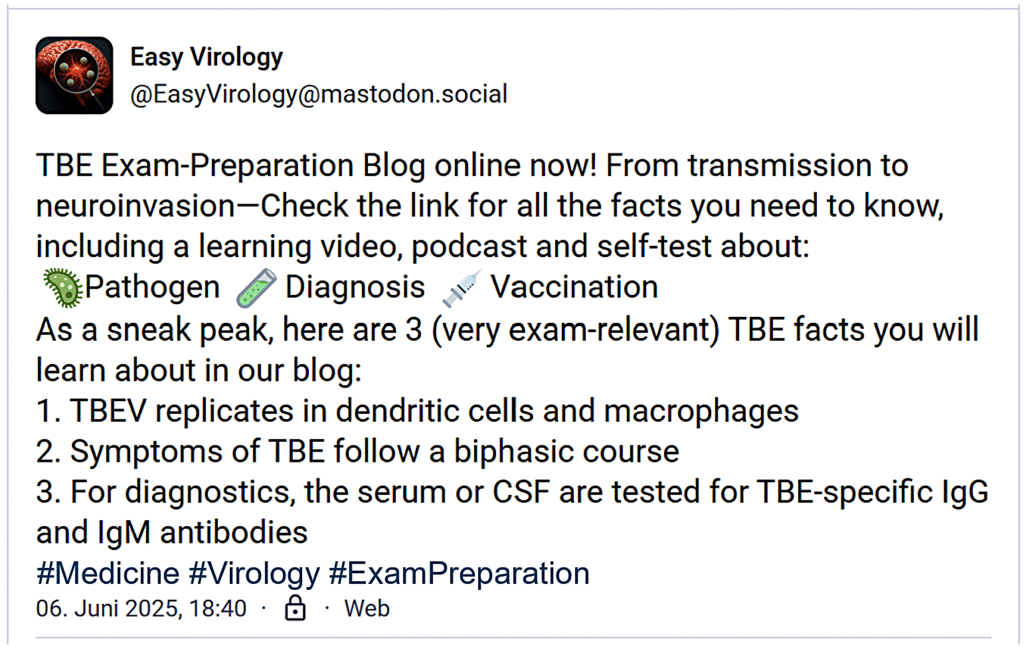
*fictional YouTube Playlist/Podcast
**fictional character
_
References
- Chiffi G, Grandgirard D, Leib SL, Chrdle A, Růžek D. Tick-borne encephalitis: a comprehensive review of the epidemiology, virology, and clinical picture. Rev Med Virol. 2023; 33(5):e2470. https://doi.org/10.1002/rmv.2470
- Bogovic, P, and Franc S. Tick-Borne Encephalitis: a review of epidemiology, clinical characteristics, and management.“ The Lancet Infectious Diseases, vol. 19, no. 4, 2019, pp. 469–478. https://doi.org/10.1016/S1473-3099(18)30454-1
- Kaiser, R. Clinical manifestations and diagnosis of tick-borne encephalitis. Journal of Neurology, vol. 267, no. 2, 2020, pp. 276–282. https://doi.org/10.1007/s00415-020-09936-w
Our Nutshells of 2025

Communicating Science: From the Lab to Everyday Life
How do you explain a virus to a politician, a traveler, or even a child? This semester, our students tackled that challenge head-on. As part of our science communication seminar Infectious Diseases Explained in a Nutshell, 24 students in 8 groups transformed complex research into engaging stories, videos, podcasts, and guides for different audiences — from patients and scientists to policymakers and the general public.
Their task: pick an infectious disease and find a creative way to make its science accessible and relevant. The results range from an “exam-ready” guide on tick-borne encephalitis to a child-friendly podcast about reptile-borne salmonella, and even a mock policy briefing on whooping cough.
What unites all these projects is a clear message — good science communication bridges the gap between knowledge and action. Here’s a look at what they came up with:
1. Explaining TBE to Students
The exam is due and you still need to grab all the facts about tick-borne encephalitis or TBE? In their exam-ready guide Franziska, Gina and Jana transformed condensed information about the viral disease and its infection mechanisms into easy to learn and snackable content.
2. Addressing politicians regarding pertussis
As an infection researcher you might be asked to or feel obliged to advise politicians on pathogens and infectious diseases. Slipping into the roles of CDC scientists, Chenguo, Wei and Ao addressed local decision-makers regarding the resurging dangers of whooping cough and made suggestions for policy priorities and counteractions.
3. Ecducating patients about HPV
Patients are a sensitive and worried target group, especially concerning sexually transmitted infections like Human Papillomavirus or HPV. To address this, “No Shame, Just Facts” was the credo of the HPV prevention guide by Yasmin, Jana and Valentina. In their blog article, they followed the story of Jade, a fictious character, who was recently tested positive for HPV. Jade learns about the virus, possible disease outcomes and prevention methods, for instance in an interview with a real HPV expert.
4. Informing scientists about OROV
Ever heard about the Oropouche virus or OROV? Neither have many scientists. So, Lea and Nick gave an overview of this South American arbovirus to medical aid staff heading into an outbreak region. A detailed video depicted what we know so far about the virus biology, though many questions are yet to be answered. Further, they discussed diagnosis, protection measures and developments that lead to the recent outbreaks.
5. Warning travelers about Dengue
Dengue is spreading rapidly nowadays and is especially prevalent in popular travel destinations. In their blog article Paula, Leonie and Anna warn backpackers that an infection with the dengue virus is “more than just a mosquito bite”. Wrapped up in a fun way, they’ve compiled all the necessary advice travelers need to know to protect themselves against infection and severe course of illness, including a quick travel checklist on social media.
6. Sharing information on TBEV with scientists
Scientists themselves might be unaware of parasites and pathogens when in the field. Therefore, Johanna, Johanna and Melina gave detailed information on TBEV or Tick-borne encephalitis virus tailored specifically to address their fellow researchers. Elaborating thoroughly on the “ecology, immune evasion and the expanding European risk landscape” of TBEV, they explained the classification of risk zones in Germany and pathogenesis on a molecular level.
7. How to explain salmonella to your kids?
Reptiles like snakes and geckos are fascinating pets and increasingly popular among children. Although harmless and low-maintenance, only few pet owners know that these animals can harbor bacteria that can cause disease also in humans. Clément, David-Vlad, Pandya and Tabitha educated about the “Hidden dangers” of reptile-borne salmonella infections. In their article, children can learn in a kid-friendly podcast and a comic video how bacteria can cause disease and how proper pet handling and hygiene gives protection.
8. Informing patients about Mpox
The Mpox virus, formerly known as monkey pox virus, has caused several epidemics throughout the last years. However, public knowledge about the pathogen, its infection route, the symptoms and available therapies is scarce. In their article “Understanding Mpox” Franziska, Alina and Imke told patients what they need to know about the virus, symptoms and prevention with the help of fictional science influencers.
From scientific facts to storytelling, our students proved that communicating infectious diseases can be both creative and impactful. Whether through comics, policy briefs, or social media campaigns, they showed how knowledge can inspire awareness and action.
If you’re curious about infectious diseases and want to learn how to bring science to life beyond the lab, join us for next year’s Infectious Diseases Explained in a Nutshell seminar!
Have you already had measles, the most devastating childhood disease?
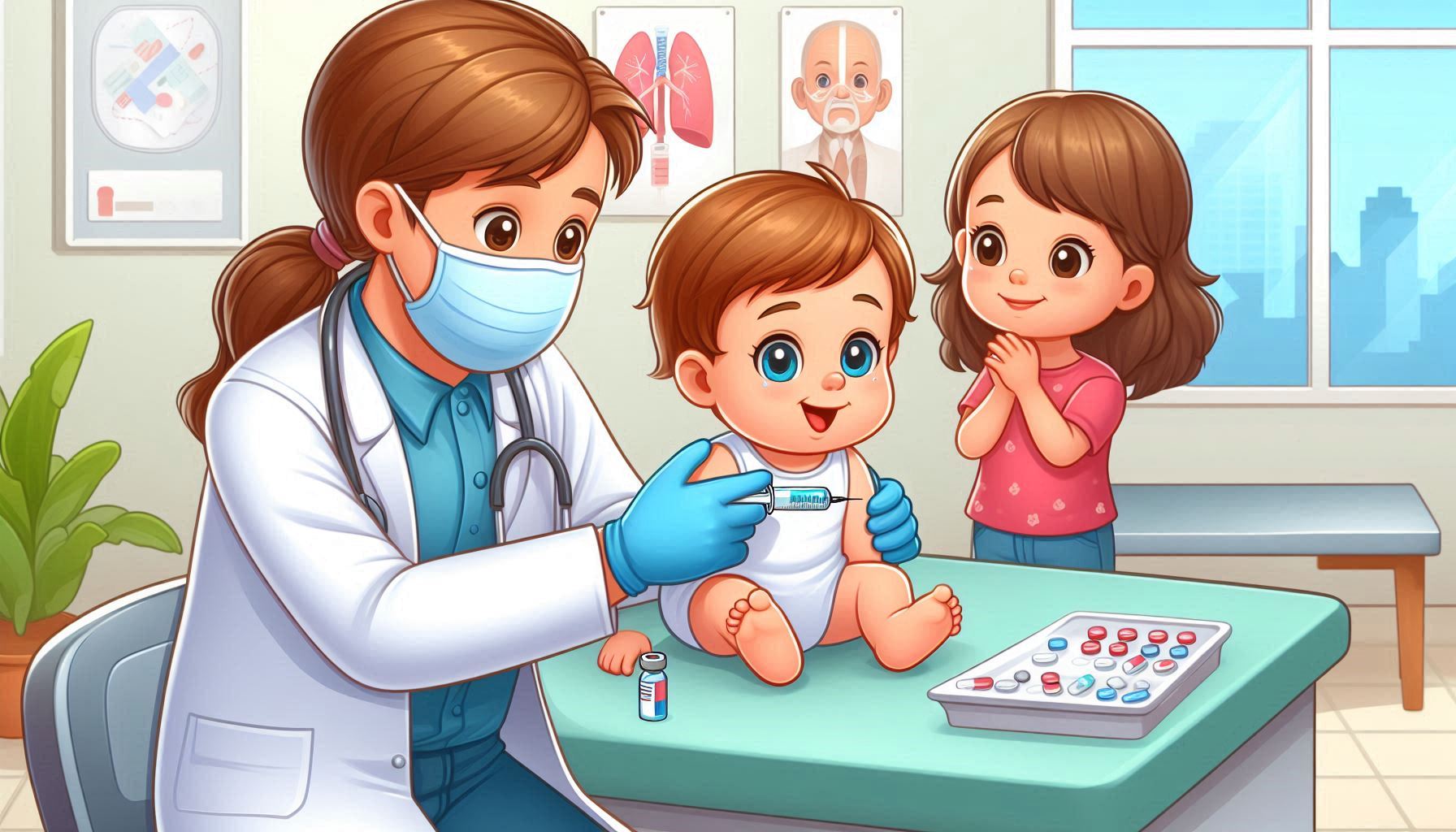
Disclaimer!
This article and its major media content are produced by students to train science communication as part of a lecture about human infectious pathogens. The article does not represent official advice from the authorities. For authorized information about the disease in question, please refer to the official health authorities in your country or the World Health Organization.
By Laura Emonds, Anna Schwartz & Franziska Steffens
Have you ever heard of the term “childhood disease”? And have you wondered why, as for the
term, only children can get sick? Why not Mom and Dad, too? We will follow Mandy*, an eightyear-
old girl, who learns about the measles disease during the current outbreaks in the USA.
Only a childhood disease?
Mandy comes home from primary school and is fed up. Instead of meeting her best friends
she must come along to her baby brother Jack’s doctor’s appointment. Her parents explain to
her that Jack will be vaccinated against measles, a childhood disease. Now Mandy is intrigued
as one of her classmates is currently sick with measles. What is a childhood disease?
Diseases are called a childhood disease when the first infection happens during the childhood.
Infected people gain lifelong immunity, which means that they won’t suffer from the same
disease again. Therefore, children get infected more often than adults. Nevertheless,
unimmunized adults can fall ill with a childhood disease, too.
And what does an infection with measles look like? Mandy watches this video that explains the
cause and symptoms of the measles disease:
Potential aftermaths of a measles infection
Those symptoms look pretty heavy, right? But most people get well after about two weeks by
treating the fever with antipyretics. Most people, but not all. A measles infection weakens your
immune system, your body’s police system against invading germs, and you can fall ill with
pneumonia or in very rare cases can suffer a meningitis. Because of these secondary
infections you can even die or suffer from lifelong consequences like paralysis.
How can you protect yourself against
measles?
Now don’t worry about getting infected with measles. These days most children are vaccinated
at age one against measles just like Mandy and her brother Jack. Maybe ask your parents if
you have been vaccinated against measles. A vaccination protects you from an infection.
There are vaccinations not just for measles but for many other diseases like e.g. chickenpox,
too. Listen to the pediatrician, who answers Mandy’s questions and explains how vaccinations
work and why they need to inject the vaccine into your arm with a syringe.
You see, a vaccination is the best way to protect you and the people around you from getting
infected as the measles disease isn’t just a harmless childhood disease. An infection can have
lethal consequences for young and adults. In some countries like eg. Germany or the USA a
vaccination against measles is compulsory for attending day care and schools as the STIKO**
stated:
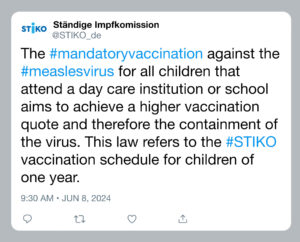
However, some people fear side effects of a vaccination or insist on their right to selfdetermination
over their own body and reject the vaccination. Nevertheless, objectively
speaking the benefits of a vaccination outweigh an unlikely risk of vaccination side effects and
prevent horrible, potential lethal courses of a measles infection.
This evening Mandy falls asleep knowing that she and her loved ones are safe just because
of one little prick.
*fictional character
**fictional social media post
About the authors:
Traveling to Africa as a Gap Year Adventure: Understanding the Risk of a Meningitis

Source: pixabay
Disclaimer!
This article and its major media content are produced by students to train science communication as part of a lecture about human infectious pathogens. The article does not represent official advice from the authorities. For authorized information about the disease in question, please refer to the official health authorities in your country or the World Health Organization.
By Franziska Broeske and Yuko Tanabe
Thinking about going on an exciting gap year adventure to Africa? Exploring new cultures, wildlife, and stunning landscapes can be an incredible experience. However, it’s important to be aware of potential health risks, including meningitis, and take necessary precautions for a safe and unforgettable journey.
The Meningitis belt
Meningitis is a bacterial infection that affects the protective membranes surrounding the brain and spinal cord. In Africa, especially in the sub-Saharan region known as the „Meningitis belt“, meningitis is more common compared to other parts of the world. Moreover, it is important to stay informed about the current infections during your trip. Keep in mind that the dry season is the most dangerous, with the risk of an infection being significantly higher. When you are interested in the latest outbreak and how the government handles the recurring outbreaks, you can read the comment, “Meningitis outbreak in Nigeria: Nigeria’s Inadequate Response to Devastating Meningitis Outbreak”, published in the newspaper TERRA*. The author criticizes the Nigerian government during the latest meningitis outbreak between October 2022 and April 2023. The bacteria involved in this outbreak are primarily Streptococcus pneumoniae and Neisseria meningitidis, which cause meningitis in young adults.
Cause and symptoms of the disease
These specific bacteria, which cause meningitis, are primarily transmitted through respiratory droplets, often spread by coughing, sneezing, or close contact with an infected person. Places like hostels, public transportation, or social gatherings can increase the risk of exposure. It is important for you to recognize the symptoms (fever, headache, vomiting …) and to be informed about the risks of a meningitis infection. Therefore, we suggest the video “Human Pathogens: Meningitis” for you to learn key facts about the infection and what actually happens in your body when you are infected with Streptococcus pneumoniae.
—
Prevention of a meningitis infection
One of the most effective ways to safeguard against meningitis is through vaccination. Conjugate vaccines are available and recommended for travelers visiting high-risk areas, including sub-Saharan Africa. Consult a healthcare professional or a travel clinic well in advance of your trip to receive the necessary vaccinations and understand the recommended schedule. To find out more about bacterial meningitis and its prevention, listen to the interview with Dr. Mark van der Linden, the head of the reference laboratory for streptococci at the Institute of Medical Microbiology at RWTH Aachen University Hospital.
—
Additional advice for a safe trip
In addition to vaccinations and vigilance, maintaining a healthy lifestyle during your trip is important. A balanced diet, regular exercise, and sufficient rest can strengthen your immune system, reducing the chances of infection. Don’t forget to purchase comprehensive travel insurance that covers medical expenses, including emergency medical evacuation. Accidents and unforeseen circumstances can occur, and having adequate insurance will provide peace of mind throughout your adventure.
Traveling to Africa during your gap year can be a transformative experience. By understanding the risks associated with meningitis and taking proactive measures, you can fully embrace the beauty of the continent, immerse yourself in diverse cultures, and create lifelong memories. Remember, your health and safety are of utmost importance, so plan wisely, stay informed, and enjoy an incredible journey exploring the wonders of Africa!
* fictional newspaper
About the authors:
 Franziska Broeske
Franziska Broeske
Master student in Biology “Medical life science”
RWTH Aachen University
 Yuko Tanabe
Yuko Tanabe
Master student in Biology “Medical life science”
RWTH Aachen University
Let’s have a Prep-Talk about Sex…
—
…ually Transmitted Infections
Disclaimer!
This article and its major media content are produced by students to train science communication as part of a lecture about human infectious pathogens. The article does not represent official advice from the authorities. For authorized information about the disease in question, please refer to the official health authorities in your country or the World Health Organization.
By Stamatis Spyridonidis and Veera Kostamo
Over the past few years, remarkable progress has been made in the field of sexually transmitted infections (STIs), particularly in the realm of prevention strategies. One approach that has gained significant attention since 2012 is Pre-Exposure Prophylaxis (PrEP). By utilising antiretroviral medication, PrEP effectively reduces the risk of acquiring HIV. However, it is crucial to consider the interconnectedness of HIV and other STIs when addressing sexual health. While the approval of PrEP has led to a decrease in HIV cases, there has been a noticeable rise in several other STIs. The question arises: why is this happening?
Understanding HIV and other Sexually Transmitted Infections (STIs)
The Human Immunodeficiency Virus (HIV) is a viral infection that targets the body’s T-cells, essential components of the immune system responsible for safeguarding against diseases. It is transmitted through specific bodily fluids such as blood, semen, vaginal fluids, and breast milk. Once inside the body, the virus replicates rapidly, gradually depleting T-cells. As the immune system weakens, individuals become more vulnerable to various infections and diseases. If it stays untreated, HIV can progress to the acquired immunodeficiency syndrome (AIDS), which currently has no effective cure. However, with proper treatment, including antiretroviral therapy (ART), people living with HIV can lead healthy lives and reduce the risk of transmitting the virus to others.
In addition to HIV, there are various other STIs that primarily spread through sexual contact, blood, or semen, causing a variety of symptoms ranging from discomfort to severe health problems. These infections can be caused by bacteria, viruses, parasites, or fungi. Examples include chlamydia, gonorrhoea, human papillomavirus (HPV), and herpes.
Understanding Numbers and Correlations: Unravelling the Relationship Between STIs and PrEP
The prevalence of four curable STIs—syphilis, gonorrhoea, chlamydia, and trichomoniasis—reached an estimated 374 million incident cases in 2020. Surprisingly, several studies have revealed that individuals using PrEP, a medication to prevent HIV transmission, experienced a higher burden of STIs after initiating the treatment. A comprehensive study done in Montreal, Cananda, spanning five years until 2015 found that the number of STI cases rose from 49 to 84 per 100 persons in the year following PrEP prescription. Although PrEP has proven highly effective against HIV, it does not provide protection against other sexually transmitted infections. The exact correlation between the rising numbers of STIs among PrEP users is still unknown. Various factors play a significant role in this trend, as mentioned in an opinion article by Dr T. Pallidum, a specialist working in the field of STIs. Whether it is a result of engaging in condomless sex, having multiple sexual partners, or adopting riskier sexual behaviours, the key is to develop new strategies to combat these infections.
Implementing Effective Strategies
In response to the rising numbers of STIs, the World Health Organization (WHO) released a new Implementation tool during the 23rd World Congress of the International Union against Sexually Transmitted Infections (IUSTI) in 2022. One crucial aspect emphasised in this implementation tool is the integration of various STI services, such as consultations and STI testing, alongside PrEP prescriptions. Regular trimonthly testing for STIs, combined with the use of PrEP medication, ensures the early detection of asymptomatic infections. Treating these infections promptly helps prevent further transmission to sexual partners.
Accessible STI Testing Centres
In every city, multiple STI testing centres can be found, offering tests for a variety of STIs either free of charge or at a minimal cost. The best part is that testing for STIs is easy, fast, and accessible. All testing centres adhere to the same principles, ensuring reliable and accurate results. To learn more about the testing process, you can refer to the video below:
—
Addressing Sexual Behaviours and Youth: Fostering Open Dialogue
Adolescents and young adults represent one of the most sexually active and risk-taking groups. As they navigate their sexuality, especially in the era of online dating, they often make choices and take risks that can put them in danger. Furthermore, due to the stigma surrounding discussions about sex, young individuals may feel hesitant to ask questions about safe practices and sexual health. To protect them, it is crucial to address the stigma surrounding sex starting from home. Parents should engage in open conversations and provide education to their children about sex, thereby removing the fear associated with discussing these topics.
Dr. Daniel Beer, a specialist in internal medicine and infectiology, shares his perspective on this topic and provides insights into how parents can help address this issue in the following interview:
While PrEP has made significant strides in reducing HIV cases, the rise of other STIs among PrEP users must be addressed. By implementing new strategies that integrate STI services with PrEP prescriptions, advocating for regular testing, and fostering open discussions about sex and safety, we can effectively combat the spread of STIs. It is important for individuals to prioritise their sexual health by taking advantage of easily accessible testing centres and staying informed about the latest advancements in STI prevention.
References:
https://doi.org/10.1007/s10461-018-2252-9
https://doi.org/10.1007/s11904-019-00446-5
Ebola Outbreak: A Global Concern and Lessons Learned for a Resilient Future
Disclaimer!
This article and its major media content are produced by students to train science communication as part of a lecture about human infectious pathogens. The article does not represent official advice from the authorities. For authorized information about the disease in question, please refer to the official health authorities in your country or the World Health Organization.
By Kerstin Lehnen and Lena Rocca
Introduction
In recent headlines, the Aachener Newspaper has highlighted a concerning development – the reemergence of Ebola in the Democratic Republic of Congo. In this article, we embark on a journey to understand the historical context of the virus, particularly the devastating outbreak from 2014 to 2016. We will also delve into the current situation in Congo, exploring the characteristics of the Sudan Ebola virus responsible for the recent outbreak. Along the way, we will provide valuable resources, including an engaging video by science influencer SciFluencis* and an enlightening podcast hosted by Sciencefacts*. Get ready to uncover the global impact of Ebola and the invaluable lessons we’ve learned along the way.
The Devastating Outbreak of 2014-2016
Between 2014 and 2016, West Africa experienced the longest and largest Ebola outbreak in history. Originating in Guinea in December 2013, the virus rapidly spread across borders, resulting in over 28,600 reported cases and a tragic death toll of 11,325. Although Germany didn’t directly witness any cases, travelers infected with the virus introduced it to the country. Through international collaboration, enhanced disease surveillance, and effective treatment measures, the epidemic was eventually brought under control.
The Current Ebola Outbreak in Congo
On August 21, 2022, the Ministry of Health of the Republic of the Congo reported a new Ebola outbreak. Confirmed through rigorous medical tests, the outbreak persisted from August 21 to September 27, 2022, with 164 reported cases. Among them, 142 cases were confirmed, while 87 patients successfully recovered and 55 tragically lost their lives. The Sudan Ebola virus was identified as the cause, posing a challenge as there are currently no approved therapeutics or vaccines for this strain.
Unraveling the Sudan Ebola Virus
Belonging to a group of six Ebola virus species, the Sudan Ebola virus is a rare but life-threatening infectious disease. Originating in wild animals, the virus is transmited to humans through contact with infected animals. Human-to-human transmission primarily occurs through physical contact with Ebola patients or deceased individuals. The virus spreads mainly through bodily fluids, necessitating robust containment and prevention measures.
Expanding Your Knowledge
To gain a deeper understanding of Ebola and its implications, we recommend exploring additional resources. SciFluencis*, renowned science influencers, have produced a captivating video titled „What is Ebola?“ that offers an in-depth explanation of the virus:
—
Furthermore, in our quest to understand the global preparedness and response efforts, we turn to the enlightening podcast hosted by Sciencefacts*. In this thought-provoking podcast episode, hosted by Laura* and Julia*, university students in the field of infectious diseases shed light on the progression of an Ebola infection:
—
Conclusion
The resurgence of Ebola in Congo serves as a powerful reminder of the persistent threat posed by this deadly virus. Yet, by embracing international collaboration, bolstering disease surveillance, and advancing treatment and prevention strategies, we can strive to minimize its impact. Our collective commitment to learning from past outbreaks and staying informed through credible resources enables us to contribute to global efforts in tackling Ebola and safeguarding public health.
Let us remember that knowledge and awareness are our greatest weapons against infectious diseases like Ebola. By staying informed and working together, we can build a future resilient to such global health challenges. Stay informed, stay safe, and join us in our pursuit of a healthier world.
*fictious characters
About the authors:
 Lena Rocca
Lena Rocca
Age 23, 2nd semester Biology M. Sc., major: Medical Life Science
 Kerstin Lehnen
Kerstin Lehnen
Age 22, 1st semester Biology M. Sc., major: Neurobiology
Avian Influenza – Current Global Situation and Risk Assessment in Germany (May 2023)
Disclaimer!
This article and its major media content are produced by students to train science communication as part of a lecture about human infectious pathogens. The article does not represent official advice from the authorities. For authorized information about the disease in question, please refer to the official health authorities in your country or the World Health Organization.
By Laura Charlier and Meryem Pehlivan
In April 2023, the Ministry of Health in Chile reported a human infection caused by avian influenza A virus (H5N1) in Chile. Avian influenza A is a highly contagious disease mainly occurring in poultry. H5N1 is the most prominent subtype of the highly pathogenic avian influenza (HPAI) detected in infected birds.
Since December 2022, more than 120 outbreaks of avian influenza in bird populations have been documented in Germany, two of which were reported in May. In some cases, other wild animals were affected. According to the Friedrich-Loeffler institute, four cases of infected foxes have been reported this year.
Transmission from animals to humans is rare but can happen due to direct contact to an infected animal or to infected material, like saliva or feces. Human-to-human transmission is extremely rare and was reported in only a few cases, mostly after prolonged and unprotected contact with an infected, symptomatic person. Learn more about the transmission paths.
The range of symptoms due to an HPAI infection begins with no symptoms or mild illness to severe disease including lower respiratory tract disease, severe pneumonia with respiratory failure and multi-organ failure. The approximate case fatality proportion is 40-50%.
According the Centers for Disease Control and Prevention (CDC), 13 cases of human infection with avian influenza A (H5N1) have been reported worldwide since 2020. There are no cases of human infections known in Germany.
The general risk for an infection with an HPAI is currently low. However, it is important to take precautions. Three main aspects for keeping the risk low should be considered:
1: Monitoring
If you had contact to a sick or dead wild bird and develop symptoms like fever, cough, headache or muscle ache, contact your local health department and follow their instructions.
***
2: Prevention
There are many ways of preventing yourself of an infection with avian influenza. The veterinarian Claudia Miller* talks about what you need to know about bird flu and the preventive steps you should always keep in mind.
***
3: Education
As children are very curious and like to play in nature, it is extremely important to teach them in young age how to behave around wild animals. The following explanatory video may help your child to understand the possible risks.
If you are a teacher in an elementary school, consider to educate your students about the bird flu and other zoonotic infections. This information material provided by the WHO visualizes important facts accessible for young children.
Informing yourself about updates is crucial in order to adapt to changes of the current situation. If you are interested, you can use further material and read about the avian flu. Always keep in mind to use trustworthy sources and check if the given information can be verified. A current statement of the infection biologist Ayda Mellinger* addresses the question how to deal with the global bird flu situation.
*fictious character
About the authors:
 Laura Charlier
Laura Charlier
Age 25, 1st semster Biology M. Sc., major: Medical Life Science
„I think it’s crucial as a scientist to communicate scientific topics to the public. It’s not only interesting and fun to create a Blog article, but also very hard to put yourself into the position of your target audience! Therefore, seminars like this are really helpful to develop communication skills.“

Meryem Pehlivan
2nd semester Biology M. Sc., majors: Microbiology and Genetics
„I think that science communication is a very important task and skill that every scientist should master. For me, this seminar was an opportunity to learn these skills.“
April 25: World Malaria Day 2023
Three Is against malaria
The world malaria report 2022 of the world health organization (WHO) states that in 2021 an estimated 247 million people were infected with malaria in 84 countries around the world with a death toll of about 619 000 people. Despite huge efforts in the eradication of the disease and constant dropping numbers throughout the last decades, levels of disease burden are still high. Especially in remote and rural areas of the tropics people are at risk without having access to appropriate prevention and health care. Among the most vulnerable groups are primarily children.
Time to deliver zero malaria: invest, innovate, implement
Therefore, each year the WHO hosts the World Malaria Day on April 25. It is a political statement to persistently raise awareness and funds for treatment and prevention. Only a continuing worldwide effort can lead to the global eradication of malaria, since risk areas include the worlds poorest countries with no access to or ressources for high-tech diagnostics, powerful medical treatments and secure life styles. This year’s World Malaria Day has been themed „Time to deliver zero malaria: invest, innovate, implement“ which comprises WHO’s goal to reduce human malaria cases to zero by
- investing in and prioritizing efforts to protect hard-to-reach and marginalized populations,
- push innovation of mosquito control, diagnostics and medical treatment,
- implementing the strategies we already have at our hands.
Who’s the killer?
Now we know that malaria kills a lot of people and causes even more disease. But what kind of agent causes malaria, how does it get into your body and what does it do there to make you feel sick? Learn about the nature and the progression of the disease, in the informative and entertaining video clip by the amazing Armando Hasudungan:
With effective drugs at hands, is malaria still so dangerous?
Successful antimalarial drugs were the hope of the last century. Unfortunately, the malaria parasite reliably develops resistance to standard drugs. This puts researchers and health officials in a constant battle to find novel drug targets within the cellular structures and the reproduction cycle of the plasmodium parasites.
Listen to Marco de Ambrogi from The Lancet Infectious Diseases talking to researcher Rob W van der Pluijm from the Centre for Tropical Medicine and Global Health at Oxford University about the situation in South East Asia:
The Lancet – Antimalarial resistance in South East Asia
(This recording is part of a podcast series of The Lancet Infectious Diseases, where among other things scientists are asked to comment on the impact of their findings.)
Vaccines – the silver lining?
But there is a new hope: a newly developed vaccine showed siginificant protection against disease in pilot studies among children in Africa. The first malaria vaccine known under the unwieldy term „RTS,S“ achieved substantial reduction of fatal malaria cases among those children. This encouraged WHO to recommend a wider use of the vaccine across high risk areas. Further studies need to determine the full efficacy and safety profile of the protection, but first steps have been made. Researchers are now aiming at reducing the numbers of shots needed for full protection and global health officials are working on a programm for efficient distribution to the vulnerable population.
More vaccine candidates are in development and even have reached clinical trials adding to the world’s arsenal to defeat malaria, maybe for good. Also BioNTech works on a malaria vaccine termed „BNT165“ based on the mRNA-technology that already came to use in Pfizer-BioNTech’s famous COVID-19 vaccine. Investing in innovation has already paid off. Let’s follow that path.
#endgamemalaria



